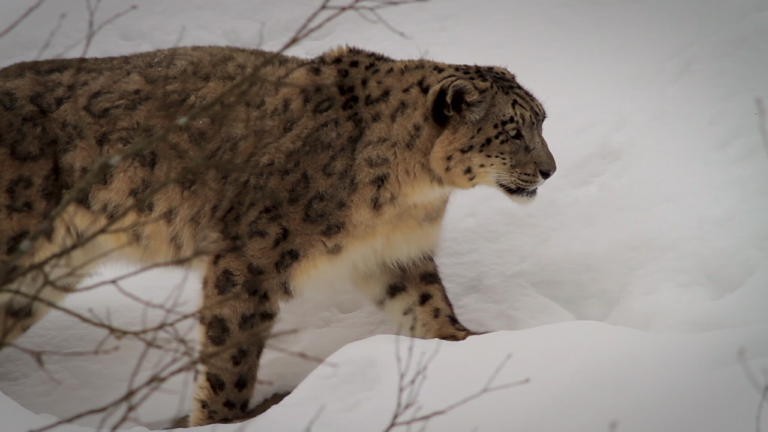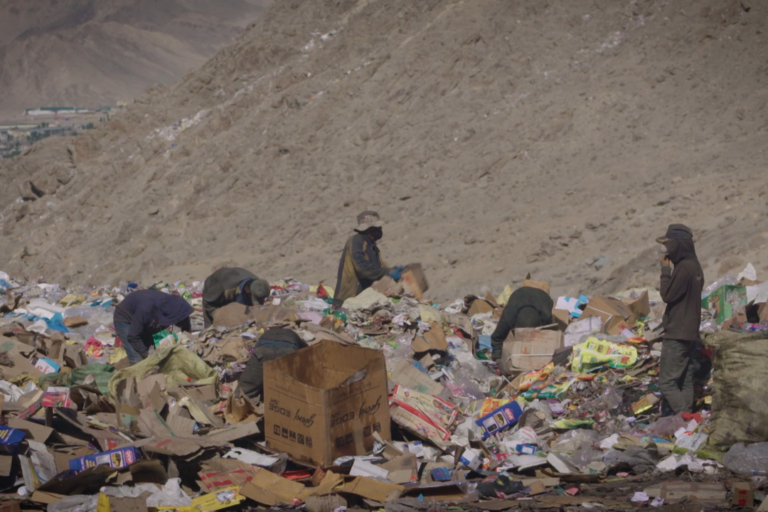- Wildlife documentary captures the elusive snow leopard and the challenges it faces for survival.
- The film, screened recently at the International Film Festival of India, follows the search for Gyamo, a female snow leopard, and her two cubs in Ladakh.
- It brings to the fore issues like garbage dumping, feral dogs attacking wildlife, habitat destruction, human-animal conflict which are challenges for the local community and also threats to the snow leopard.
The elusive snow leopard, found primarily in the mountainous regions of central and southern Asia, has always fascinated wildlife lovers and conservationists. But, the mystery around this enchanting cat also makes it highly vulnerable, highlighting the need for more research to save the species.
Throwing light on such issues is a wildlife documentary, ‘Gyamo – Queen of the mountains’, which documents the search for a female snow leopard and her cubs in Ladakh. The film, produced by Riverbank Studios and written and directed by Doel Trivedy and Gautam Pandey was recently screened at the 49th International Film Festival of India (IFFI) in Goa and also won accolades at the United Nations-sponsored International Big Cats Film Festival organised by Jackson Hole Wildlife Film Festival, earlier this year.
“You realise what ‘needle in a haystack’ means when you go looking for a snow leopard amongst the snow and mountains,” said veteran wildlife filmmaker and producer of this documentary Mike Pandey, while speaking to Mongabay-India. He stated that this was one of the toughest documentaries he has shot, filming at an altitude of 18,600 feet and temperatures that could even drop to minus 40 degree Celsius.

Elaborating on this relationship between the snow leopard and the Himalayan region he added, “The trans-Himalayan region is a very fragile ecosystem on the planet and it also happens to be the source of water for India, China and other neighbouring countries. One could easily call it the ‘third pole’. It supports over 50 percent of Indian’s population in terms of water and right now it is under threat. One of the custodians or the balance of the fragile ecosystem is the snow leopard.”
The 42-minute documentary explores the journey of father-son wildlife filmmakers Mike Pandey and Gautam Pandey to the Ladakh region of Jammu and Kashmir where they are on a mission to find the cubs of a female snow leopard, Gyamo. Having cubs is a sign of a healthy habitat. But, on this journey they realise that along with larger issues of habitat destruction and poaching, these snow leopards are faced with many other challenges, including feral dogs.
“Snow leopard is like a holy grail for wildlife filmmakers,” said Gautam Pandey on the sidelines of IFFI in Goa. Gautam first discovered pug marks of this furry cat quite by an accident when he visited Ule village in Ladakh, more than three years ago. He then, with the help of the forest department of Ladakh, placed camera traps in the region. The cameras captured the movement of Gyamo, her two cubs and also a male snow leopard, raising suspicion that the male leopard could be preying on the cubs.

This documentary takes forward this journey as the team goes on to search for Gyamo and her two cubs, documenting moments like the smoky-fur cat walking in the white snow followed by her two cubs and camouflaging with the ridges and mountains of Ladakh. The film focuses on the conservation of these cats and the threats faced by them.
“We make conservation-based films and not just about wildlife,” said Gautam, adding that when they were working on this documentary they came across various problems faced by locals and villagers. The one major issue is the landfill site at Leh where all the garbage of the town, generated mainly due to tourism, is dumped. It is estimated that around 30,000 plastic bottles are dumped here during tourist season.
“It is little bit naive to think that there will be no garbage (in Ladakh). It is the tourism industry which is directly responsible for it as locals live within means. We felt very irresponsible on our part not to talk about it,” said Gautam. This landfill is also one of the reasons for the increase in the population of feral dogs. There are more than 5,000 dogs in Ladakh alone, according to the filmmakers and they are one of the threats to wildlife as they tend to kill animals by forming packs. There is also a mix breed between wolf and dogs found in Ladakh, locally known as “Kipshang”. “They are wild. They form packs with domestic dogs and hunt. Also feral dogs are bigger threat to wildlife now as there are 30 million feral dogs in India now. The answer is all known but we don’t do anything about it,” said Gautam.

The snow leopard is listed as Vulnerable on the IUCN-World Conservation Union’s Red List of the Threatened Species. But, yet there is no official figure on the number found in the wild today. It is estimated that they are around 4,500 to 10,000, claims the film. “No one knows the official figure as it is very hard to do that. I know in Kyrgyzstan they have done extensive camera trapping and are probably the first to get an actual number for Kyrgyzstan. In Ladakh, the forest department and some NGOs are working on figuring out how many snow leopards we have in India,” said Gautam.
Along with these threats, the documentary focuses on human-animal conflict and poaching of snow leopards for their fur. However, in places like Ladakh there is a fair bit of awareness when it comes to human-animal conflict. There are now various NGOs, which the film speaks about, working on finding practical solution for these problems.
“Hunters have wiped out ibexes, which are the prey species of the snow leopard. So, they are forced to come to remote habitations in search of food. Sheep, goats are then easy target for them. But when they (goats) are killed there’s retaliation as then farmers poison the goat (in order to kill the snow leopard) or sometimes throw stones at them. But that is changing with lot of awareness by NGOs who work on covering the cattle shed and also through the films like we made,” said Mike.
He is of the opinion that documentaries like “Gyamo – Queen of the Mountains” appeals at three levels — it makes locals aware, appeals to policy makers and creates an understanding about these issues among the general audience.

He suggested that the presence of snow leopards can help the region get tourism and thus earn revenue for the locals. “It is important for policy makers to manage the waste generated by the tourists. It is now one of the threats as the population of feral dogs has increased,” said Mike.
Even though documentaries and films make an attempt to create awareness, there’s a risk of these films either romanticising the wildlife or projecting the wild animals as predators. Both Gautam and Doel confess that indeed it is a trend and at the end of the day it is the decision of the filmmaker. “We are constantly aware that we are walking that fine line. So, once you are aware of it, it becomes organic. Like in this film, organically local issues came while we were writing the script and meeting the people,” said Trivedy, who further gave an example of the environment show on Doordarshan, “Earth Matters” which was on air for more than 14 years and was dubbed in five languages. “The show went to the remote corners of the country. It changed something in their lives, I know people who stopped using plastic, turned vegetarian, said Trivedy. “Ground level change is possible through films. Most recently we did a film on horse shoe crab which helped in allowing legislative change. So, when you talk about it or tweet about it, policy guys will at least look into it,” she said.

However, along with these films, the team believes that situations have to change at ground level. Mike suggests that it is high time now that we change our lifestyle in order to make it more sustainable. Adds Gautam, quoting the monk from his documentary, “Take care of our own nest as Rinpoche says. We need to take care of our own corner.”
Banner image: A snow leopard in Ladakh. Photo courtesy Gautam Pandey.
